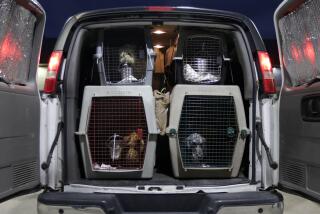Research Rodent Breeders Are Winning the Rat Race
- Share via
Build a better mouse and you can beat a path to the bank.
One of the lesser-known growth industries nationally has become the breeding and selling of rodents for research--much to the disapproval of animal rights activists.
Although research facilities at California hospitals and laboratories use rodents, most of the mice and rats come from elsewhere. And, of the few small breeding and selling establishments that operate in California, spokespeople for them unanimously declined to be interviewed, all citing the zeal of the animal rights activists.
Even the spokeswoman for a company that merely transports the animals to research centers said that under no circumstances would she agree to seeing the company’s name in print.
$100-Million Business
Be that as it may, rodent vending to researchers amounted to nearly a $100-million business last year.
“In 1985 the value of mice bred and sold for that purpose totaled $34 million,” Phyllis Klaben said. “For rats, the total was $51 million.”
Klaben is marketing vice president of Theta Corp., a Middlefield, Conn., firm that issues marketing reports on health care.
“Basically, 10 major companies are involved, mostly on the East Coast,” she said.
Speaking by phone from Bar Harbor, Me., Barbara Trevett was more than willing to talk about the Jackson Laboratory, of which she is assistant director of development.
That lab breeds mice carrying specific mutant genes and includes such creatures as “Snell’s waltzers,” which characteristicly circle.
Other varieties in the catalogue include the Trembly, Twister, Leaner, Stumbler, and the Jackson Shaker--used by researchers in such diseases as multiple sclerosis.
“We breed 900 strains of mice, and this brings in $10 million a year,” Trevett said. “We rear more than 3-million mice annually, which we distribute to 29 nations.”
It all started in 1929, when geneticist Clarence Cook Little brought to the island town a group of students, who lived in tents and caught field mice. From this the Jackson Laboratory has grown to a nonprofit facility of 29 buildings on 87.5 wooded acres, a leader in genetics research, not affiliated with any hospital or university. It is involved in cancer, diabetes, heart disease, muscular dystrophy and aging research.
And supporting a large part of this is the income from good mousekeeping. “We offer the largest variety of mice in the world,” Trevett said. “We breed or sell nothing else.”
Everything is mail order--and to the scientific community only. Indeed, the laboratory publishes a 42-page catalogue. Prominent on the first page is a statement that any sales are “conditional upon agreement by the recipient that the mice and their descendants, if any, will be used solely for research purposes.”
Mice price varies from roughly $4 for one of the inbred strains to $20.40 for certain mutant stocks.
Used to Study Diseases
“There are a wide range of human diseases for which there are rodent models that can be used to study these diseases,” said Dorothy Greenhouse of the Institute of Laboratory Animal Resources in Washington.
“Although there are some diseases for which there are no rodent models, the situation is improving all the time,” said Greenhouse, senior program officer. “A model is an animal that has a physiology or a pathology that in one or more respects resembles the human situation.”
Such is the extent of usage of rodents that there is even a “Mouse News Letter” ranging from 100 to 125 pages and published thrice annually by Oxford University Press for $12 per issue.
“It is a scientific journal which provides up-to-date information on mouse mutants, variants, linkages and inbred strains,” copywriter Wini Moranville said from New York City.
To say the least, the whole scene doesn’t sit well with animal rights activists.
“Organizations such as ours would like to see the day come when these unfortunate animals aren’t used for research, and there would be no need to breed and sell them,” said Mary Flint, executive director of Actors and Others for Animals.
“There is so much unnecessary duplication in the research field,” she said from the organization’s North Hollywood headquarters. “It isn’t enough to say that this will help people, because a lot of it doesn’t do that. The research community exaggerates.”
Rights Groups Criticized
On the other side is Sandra Bressler, executive director of the California Biomedical Research Assn., which is headquartered in Berkeley.
“The animal rights people are saying ‘This is big business, and therefore that is the conclusive thing,’ ” she said. “The (rodent breeding) companies wouldn’t exist without the enterprise, but the enterprise is fundamental. There is clearly a need for biomedical research that uses laboratory animals, and the industry provides a service to that enterprise.”
And while California may not have much in the way of such an industry, its many research facilities are good customers.
“We buy more than 1,000 mice a year from Jackson,” said Jose Lopez-Tiana, senior buyer assistant in the purchasing department at Caltech in Pasadena.
“For some of the exotic strains, we have to go on a waiting list. Some of them are in real demand. Sometimes we have to wait six months or longer.”
And the business grows. According to projections by Theta Corp., dollar sales of rodents will increase 8% this year and next, and 7% in each of the following three years.






